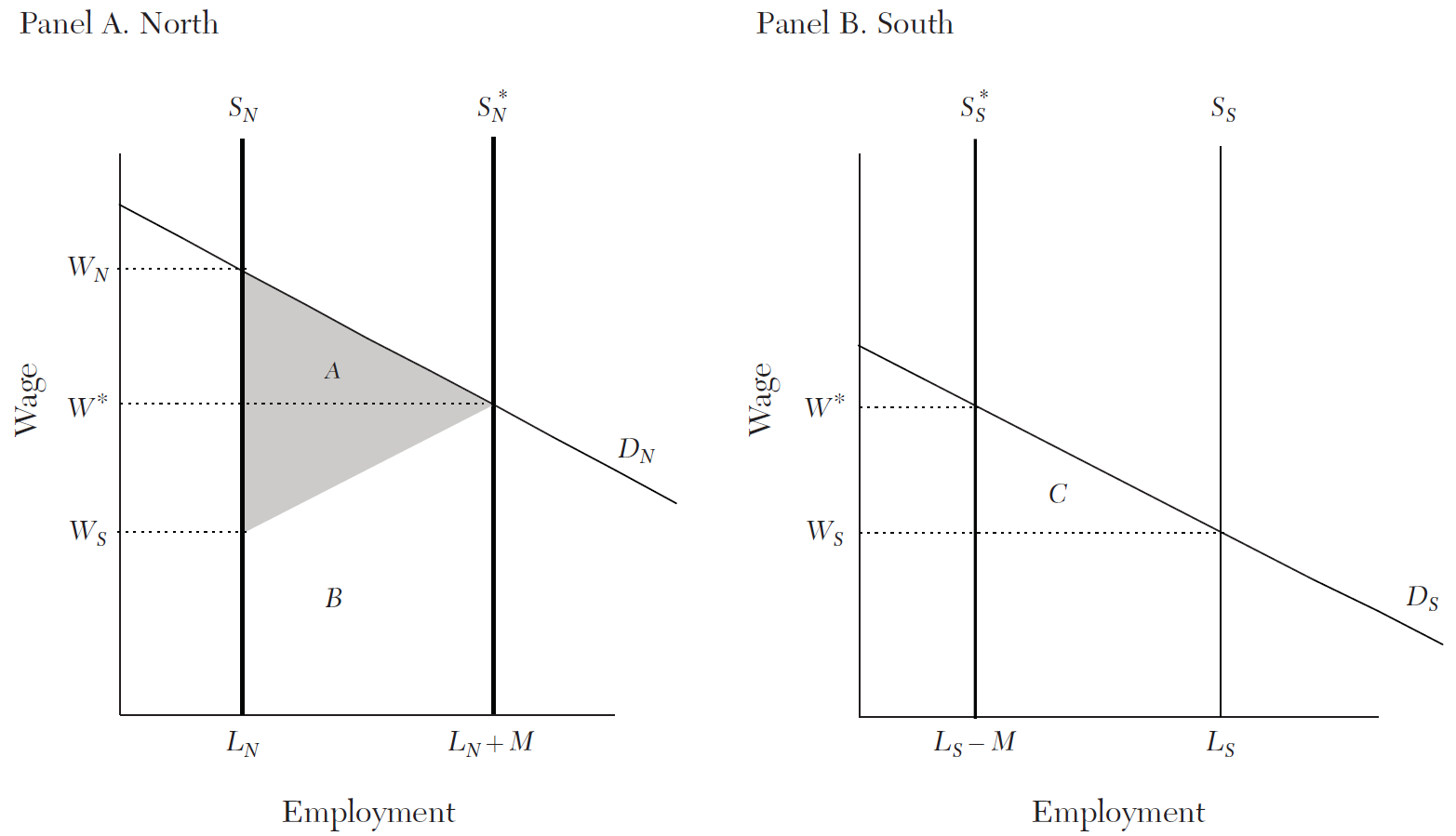
The immigration surplus made concrete, on paper:
- North’s gain from Southern workers, trapezoid B, equals South’s loss, trapezoid C.
- North’s total gain, trapezoid AB, is bigger than South’s loss, trapezoid C. The difference is the total immigration surplus: trapezoid AB‘s shaded portion, which is triangle A.
- This is idealized with migration costless; and with poor Southern immigrants suddenly producing like rich Northern natives; and with migration continuing when Northern natives’ wages fall.
Immigration surplus has been called a world GDP increase of 60%
To get a better grasp of the issues at hand, it is best to begin with a description of the basic model.
As in the generic study in the literature, the removal of immigration restrictions (combined with the assumption of costless mobility) would lead to a huge increase in world GDP. Specifically… world GDP would increase by $40 trillion, almost a 60 percent increase. Moreover, these gains would accrue each year after the migration occurs, so that the present value of the gains nears one quadrillion dollars!
…if only countries would stop being countries.
Immigration surplus that big would take exodus of 95%, productivity leap, native wages down 40%
The simulation implies that 2.6 billion workers, or 95 percent of the workforce in the South, will move. If these workers bring along their families, the 95 percent mobility rate implies that nearly 5.6 billion persons would move from the South to the North.
For immigration to generate substantial global gains, it must be the case that billions of immigrants can move to the industrialized economies without importing the “bad” organizations, social models, and culture that led to poor economic conditions in the source countries in the first place.
The formation of social networks among migrants could substantially lower the costs of migration for the second or third billionth mover. But congestion costs in the receiving countries could also increase exponentially, making it harder to resettle that marginal migrant.
The earnings of the North’s native workforce fall by almost 40 percent, and the earnings of Southern workers increase by 143 percent.
A little humility about what we actually know would seem to be a prerequisite before anyone proposes a breathtaking rearrangement of the world order. …it seems likely that a particular [immigration] policy is chosen because that choice leads to the greatest benefits and/or smallest costs in that place and at that time.[1]
Immigration surplus could plausibly come from emigration of 12%, with productivity lag
In this paper, we quantify the effect of a complete liberalization of cross-border migration on the world GDP and its distribution across regions.
As for desired migration, we aggregate four waves of the Gallup World Poll survey… About 290,000 adults from 142 countries were questioned about their desired migration and preferred country of destination. These countries are representative of about 97 percent of the world population.
Data on potential migration reveal that the number of people in the world who have a desire to migrate is around 400 million. For the year 2000, we identify 274.5 million desiring migrants aged 25 and over. Adding them to the effective migrants gives a total stock of 386.1 million potential migrants (i.e., 12.1 percent of the population).
Most of these desiring migrants originate in poor countries and want to relocate to rich countries.
The main regions of origin are Asia (30 percent of the total, including China and India), sub-Saharan Africa (17 percent), Latin America (14 percent), and the Middle East and Northern Africa (8 percent).
In terms of destinations, a vast majority want to emigrate to an OECD, high-income country (27 percent to the United States, 26 percent to Europe, and 16 percent to Canada, Australia, and New Zealand). Other important destinations are Japan, Singapore, Saudi Arabia, and the United Arab Emirates.
It is widely documented that many immigrants with higher education tend to find jobs in occupations typically staffed by less-educated natives… Highly educated immigrants trained in developing countries, in particular, are likely to be less productive in high-skill jobs than natives with similar educational degrees.
Plausible immigration surplus in the first generation could be world GDP increase of 7%
…when total factor productivity (TFP) is an increasing function of the proportion of college graduates in the country’s labor force… in the medium term… (i.e., over one generation)… liberalizing migration increases the world GDP by… in the range of 7.0 percent…[2]
- Borjas, George J. “Immigration and globalization: A review essay.” Journal of Economic Literature 53.4 (2015): 961-974.
- Docquier, Frédéric, Joël Machado, and Khalid Sekkat. “Efficiency gains from liberalizing labor mobility.” The Scandinavian journal of economics 117.2 (2015): 303-346.